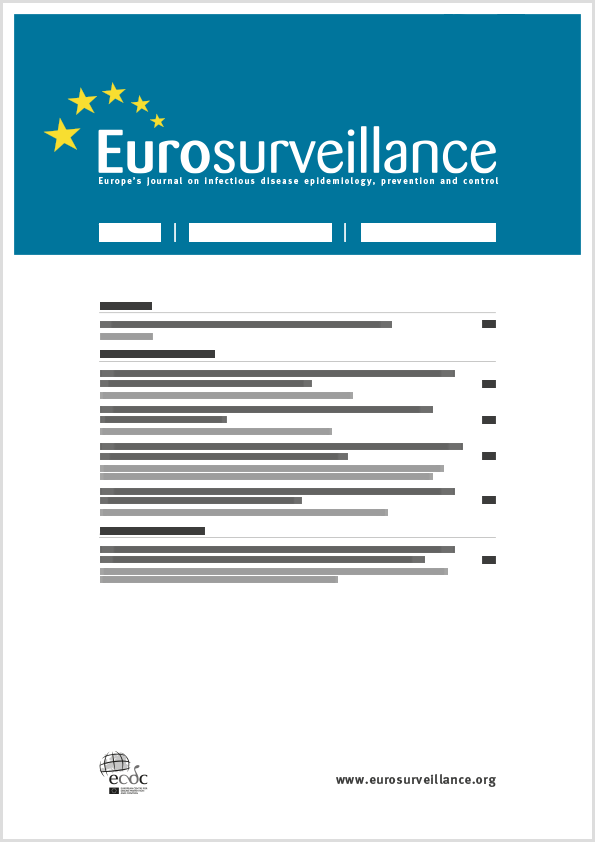- Home
- Eurosurveillance
- Previous Issues
- Volume 17, Issue 18, 03/May/2012
Eurosurveillance - Volume 17, Issue 18, 03 May 2012
Volume 17, Issue 18, 2012
- Editorials
- Rapid communications
-
-
-
Possible contamination of organ preservation fluid with Bacillus cereus: the United Kingdom response
More LessWe describe here the United Kingdom (UK) response following the recent international recall of an organ preservation fluid owing to potential Bacillus cereus contamination. This fluid is used for the transport of solid organs and pancreatic islet cells for transplant. We detail the response mechanisms, including the initial risk stratification, investigatory approaches, isolate analysis and communications to professional bodies. This report further lays out the potential need for enhanced surveillance in UK transplant patients.
-
-
-
First estimates of influenza vaccine effectiveness among severe influenza cases, France, 2011/12
I Bonmarin , E Belchior , Y Le Strat and D Lévy-BruhlMore LessFollowing a suspected virus-vaccine mismatch, the screening method was used to estimate in almost real time the influenza vaccine effectiveness (VE) against severe cases in high-risk individuals. Data on vaccination status were provided by the influenza severe surveillance system and data on vaccination coverage by the National Social Security Scheme. The analysis showed a decline of the vaccine effectiveness in 2011/12 (VE: 30% (95% CI: 22-39)) compared to 2010/11 (VE: 53% (95% CI: 40-67)).
-
- Top
-
- Research articles
-
-
-
Four multifaceted countrywide campaigns to promote hand hygiene in Belgian hospitals between 2005 and 2011: impact on compliance to hand hygiene
More LessFour consecutive one-month campaigns were organised to promote hand hygiene in Belgian hospitals between 2005 and 2011. The campaigns included a combination of reminders in wards, educational sessions for healthcare workers, promotion of alcohol-based hand rub use, increasing patient awareness, and audits with performance feedback. Prior and after each one month intervention period, the infection control teams measured hand hygiene compliance of healthcare workers by direct observation using a standardised observation roster. A total of 738,367 opportunities for hand hygiene were observed over the four campaigns. Compliance with hand hygiene significantly increased from 49.6% before to 68.6% after the intervention period for the first, from 53.2% to 69.5% for the second, from 58.0% to 69.1% for the third, and from 62.3% to 72.9% for the fourth campaign. The highest compliance rates were consistently observed in paediatric units. Compliance rates were always markedly lower among physicians than nurses. After patient contact and body fluid exposure risk, compliance rates were noticeably higher than before patient contact and performing aseptic procedures. We conclude that repeated countrywide campaigns to promote hand hygiene result in positive long-term outcomes. However, lower compliance rates among physicians compared with nurses, before patient contact, and before performing aseptic procedures remain challenges for future campaigns.
-
- Top
-
- Review articles
-
-
-
Influenza-related deaths - available methods for estimating numbers and detecting patterns for seasonal and pandemic influenza in Europe
A Nicoll , B C Ciancio , V Lopez Chavarrias , K Mølbak , R Pebody , B Pedzinski , P Penttinen , M van der Sande , R Snacken and M D Van KerkhoveMore LessTwo methodologies are used for describing and estimating influenza-related mortality: Individual-based methods, which use death certification and laboratory diagnosis and predominately determine patterns and risk factors for mortality, and population-based methods, which use statistical and modelling techniques to estimate numbers of premature deaths. The total numbers of deaths generated from the two methods cannot be compared. The former are prone to underestimation, especially when identifying influenza-related deaths in older people. The latter are cruder and have to allow for confounding factors, notably other seasonal infections and climate effects. There is no routine system estimating overall European influenza-related premature mortality, apart from a pilot system EuroMOMO. It is not possible at present to estimate the overall influenza mortality due to the 2009 influenza pandemic in Europe, and the totals based on individual deaths are a minimum estimate. However, the pattern of mortality differed considerably between the 2009 pandemic in Europe and the interpandemic period 1970 to 2008, with pandemic deaths in 2009 occurring in younger and healthier persons. Common methods should be agreed to estimate influenza-related mortality at national level in Europe, and individual surveillance should be instituted for influenza-related deaths in key groups such as pregnant women and children.
-
- Top
-
- Miscellaneous
-
Volumes & issues
-
Volume 29 (2024)
-
Volume 28 (2023)
-
Volume 27 (2022)
-
Volume 26 (2021)
-
Volume 25 (2020)
-
Volume 24 (2019)
-
Volume 23 (2018)
-
Volume 22 (2017)
-
Volume 21 (2016)
-
Volume 20 (2015)
-
Volume 19 (2014)
-
Volume 18 (2013)
-
Volume 17 (2012)
-
Volume 16 (2011)
-
Volume 15 (2010)
-
Volume 14 (2009)
-
Volume 13 (2008)
-
Volume 12 (2007)
-
Volume 11 (2006)
-
Volume 10 (2005)
-
Volume 9 (2004)
-
Volume 8 (2003)
-
Volume 7 (2002)
-
Volume 6 (2001)
-
Volume 5 (2000)
-
Volume 4 (1999)
-
Volume 3 (1998)
-
Volume 2 (1997)
-
Volume 1 (1996)
-
Volume 0 (1995)
Most Read This Month

-
-
Detection of 2019 novel coronavirus (2019-nCoV) by real-time RT-PCR
Victor M Corman , Olfert Landt , Marco Kaiser , Richard Molenkamp , Adam Meijer , Daniel KW Chu , Tobias Bleicker , Sebastian Brünink , Julia Schneider , Marie Luisa Schmidt , Daphne GJC Mulders , Bart L Haagmans , Bas van der Veer , Sharon van den Brink , Lisa Wijsman , Gabriel Goderski , Jean-Louis Romette , Joanna Ellis , Maria Zambon , Malik Peiris , Herman Goossens , Chantal Reusken , Marion PG Koopmans and Christian Drosten
-
- More Less


